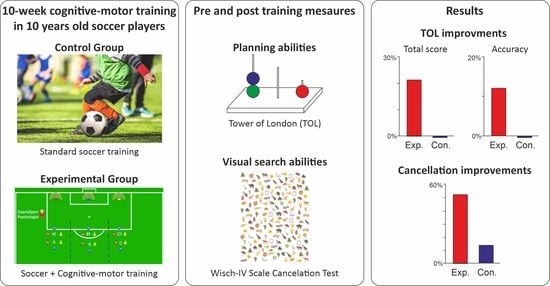The Influence of a Specific Cognitive-Motor Training Protocol on Planning Abilities and Visual Search in Young Soccer Players
Abstract
1. Introduction
2. Materials and Methods
2.1. Participants
2.2. Procedure
2.2.1. Cognitive Battery Tests
2.2.2. Intervention
2.3. Data Analysis
3. Results
4. Discussion
5. Conclusions
6. Limits
Author Contributions
Funding
Institutional Review Board Statement
Informed Consent Statement
Data Availability Statement
Conflicts of Interest
References
- Shaffer, D.R.; Kipp, K. Developmental Psychology: Childhood and Adolescence, 9th ed.; Wadsworth Cengage Learning: Mason, OH, USA, 2014. [Google Scholar]
- Diamond, A. Executive functions. Annu. Rev. Psychol. 2013, 64, 135–168. [Google Scholar] [CrossRef] [PubMed]
- Zelazo, P.D. Executive function: Reflection, iterative reprocessing, complexity, and the developing brain. Dev. Rev. 2015, 38, 55–68. [Google Scholar] [CrossRef]
- Alesi, M.; Bianco, A.; Luppina, G.; Palma, A. Improving Children’s Coordinative Skills and Executive Functions: The Effects of a Football Exercise Program. Percept. Mot. Ski. 2016, 122, 27–46. [Google Scholar] [CrossRef] [PubMed]
- Van der Fels, I.M.; Te Wierike, S.C.; Hartman, E.; Elferink-Gemser, M.T.; Smith, J.; Visscher, C. The relationship between motor skills and cognitive skills in 4–16-year-old typically developing children: A systematic review. J. Sci. Med. Sport 2015, 18, 697–703. [Google Scholar] [CrossRef]
- Libertus, K.; Landa, R.J. The Early Motor Questionnaire (EMQ): A parental report measure of early motor development. Infant Behav. Dev. 2013, 36, 833–842. [Google Scholar] [CrossRef] [PubMed]
- Bidzan-Bluma, I.; Lipowska, M. Physical Activity and Cognitive Functioning of Children: A Systematic Review. Int. J. Environ. Res. Public Health 2018, 15, 800. [Google Scholar] [CrossRef] [PubMed]
- Stolen, T.; Chamari, K.; Castagna, C.; Wisloff, U. Physiology of Soccer. Sports Med. 2005, 35, 501–536. [Google Scholar] [CrossRef]
- Vestberg, T.; Gustafson, R.; Maurex, L.; Ingvar, M.; Petrovic, P. Executive Functions Predict the Success of Top-Soccer Players. PLoS ONE 2012, 7, 34731. [Google Scholar] [CrossRef]
- Williams, A.M.; Reilly, T. Talent identification and development in soccer. J. Sports Sci. 2000, 18, 657–667. [Google Scholar] [CrossRef]
- Roca, P.; Ford, P.R.; Mcrobert, A.; Williams, A. Identifying the processes underpinning anticipation and decision-making in a dynamic time-constrained task. Cogn. Process. 2011, 12, 301–310. [Google Scholar] [CrossRef]
- Savelsbergh GJ, P.; Van der Kamp, J.; Williams, A.M.; Ward, P. Anticipation and visual search behaviour in expert soccer goalkeepers. Ergonomics 2005, 48, 1686–1697. [Google Scholar] [CrossRef] [PubMed]
- Esposito, G.; Ceruso, R.; D’Elia, F. The importance of a technical-coordinative work with psychokinetic elements in the youth sectors of soccer academies. J. Phys. Educ. Sport 2019, 19, 1843–1851. [Google Scholar] [CrossRef]
- Friedman, N.P.; Miyake, A. Unity and diversity of executive functions: Individual differences as a window on cognitive structure. Cortex 2017, 86, 186–204. [Google Scholar] [CrossRef]
- Stuss, D.T. Biological and psychological development of executive functions. Brain Cogn. 1992, 20, 8–23. [Google Scholar] [CrossRef]
- Lucia, S.; Bianco, V.; Boccacci, L.; Di Russo, F. Effects of a cognitive-motor training on anticipatory brain functions and sport performance in semi-elite basketball players. Brain Sci. 2021, 12, 68. [Google Scholar] [CrossRef]
- Lucia, S.; Bianco, V.; Di Russo, F. Specific effect of a cognitive-motor dual-task training on sport performance and brain processing associated with decision-making in semi-elite basketball players. Psychol. Sport Exerc. 2022, 64, 102302. [Google Scholar] [CrossRef]
- Orsini, A.; Pezzuti, L.; Picone, L. Wechsler Intelligence Scale for Children IV—Italian Edition; Giunti, OS: Florence, Italy, 2012. [Google Scholar]
- Faul, F.; Erdfelder, E.; Buchner, A.; Lang, A.G. Statistical power analyses using G*Power 3.1: Tests for correlation and regression analyses. Behav. Res. Methods 2009, 41, 1149–1160. [Google Scholar] [CrossRef] [PubMed]
- Shallice, T. Specific impairments of planning. Philos. Trans. R. Soc. Lond. Biol. 1982, 298, 199–209. [Google Scholar] [CrossRef]
- Wechsler, D. Weschsler Intelligence Scale for Children, 4th ed.; Italian Version Firenze, Giunti O.S: Florence, Italy, 2006. [Google Scholar]
- Pietrocini, G.; Rubba, M. Psychokinetics Applied to the Development of Technical Skills; Calzetti Mariucci: Perugia, Italy, 2013. [Google Scholar]
- Calligaris, A. Psychokinetic Approach to Football, Neuropsychological and Sensory-Perceptive Aspects; Calzetti Mariucci: Perugia, Italy, 2013. [Google Scholar]
- Alesi, M.; Bianco, A.; Padulo, J.; Luppina, G.; Petrucci, M.; Paoli, A.; Palma, A.; Pepi, A. Motor and cognitive growth following a Football Training Program. Front. Psychol. 2015, 6, 1627. [Google Scholar] [CrossRef]
- Chang, Y.K.; Tsai, C.L.; Hung, T.M.; So, E.C.; Chen, F.T.; Etnier, J.L. Effects of acute exercise on executive function: A study with a Tower of London Task. J. Sport Exerc. Psychol. 2011, 33, 847–865. [Google Scholar] [CrossRef]
- Williams, A.M.; Ward, P.; Bell-Walker, J.; Ford, P.R. Perceptual-cognitive expertise, practice history profiles and recall performance in soccer. Brit. J. Psychol. 2012, 103, 393–411. [Google Scholar] [CrossRef] [PubMed]
- Pasulka, J.; Jayanthi, N.; McCann, A.; Dugas, L.R.; LaBella, C. Specialization patterns across various youth sports and relationship to injury risk. Physician Sports Med. 2017, 45, 344–352. [Google Scholar] [CrossRef] [PubMed]
- Rusciano, A.; Corradini, G.; Stoianov, I. Neuroplus biofeedback improves attention, resilience, and injury prevention in elite soccer players. Psychophysiology 2017, 54, 916–926. [Google Scholar] [CrossRef]
- Broadbent, D.P.; Causer, J.; Williams, A.M.; Ford, P.R. Perceptual- cognitive skill training and its transfer to expert performance in the field: Future research directions. Eur. J. Sport Sci. 2015, 15, 322–331. [Google Scholar] [CrossRef]
- Broadbent, D.P.; Causer JO, E.; Ford, P.R.; Williams, A.M. Contextual interference effect on perceptual–cognitive skills training. Med. Sci. Sports Exerc. 2015, 47, 1243–1250. [Google Scholar] [CrossRef] [PubMed]
- Hadlow, S.M.; Panchuk, D.; Mann, D.L.; Portus, M.R.; Abernethy, B. Modified perceptual training in sport: A new classification framework. J. Sci. Med. Sport 2018, 21, 950–958. [Google Scholar] [CrossRef] [PubMed]
- Renshaw, I.; Davids, K.; Araújo, D.; Lucas, A.; Roberts, W.M.; Newcombe, D.J. Evaluating weaknesses of “Perceptual-Cognitive Training” and “Brain Training” methods in sport: An ecological dynamics critique. Front. Psychol. 2019, 9, 2468. [Google Scholar] [CrossRef]
- Schumacher, N.; Reer, R.; Braumann, K.M. On-Field Perceptual-Cognitive Training Improves Peripheral Reaction in Soccer: A Controlled Trial. Front. Psychol. 2020, 11, 1948. [Google Scholar] [CrossRef] [PubMed]
- Larkin, P.; Mesagno, C.; Berry, J.; Spittle, M.; Harvey, J. Video-based training to improve perceptual cognitive decision–making performance of Australian football umpires. J. Sports Sci. 2018, 36, 239–246. [Google Scholar] [CrossRef]
- Brenton, J.; MÜller, S.; Harbaugh, A.G. Visual-perceptual training with motor practice of the observed movement pattern improves anticipation in emerging expert cricket batsmen. J. Sports Sci. 2019, 37, 2114–2121. [Google Scholar] [CrossRef] [PubMed]
- Schwab, S.; Memmert, D. The impact of a sports vision training program in youth field hockey players. J. Sports Sci. Med. 2012, 11, 624–631. [Google Scholar] [PubMed]
- Diamond, A.; Lee, K. Interventions shown to aid executive function development in children 4 to 12 years old. Science 2011, 333, 959–964. [Google Scholar] [CrossRef] [PubMed]
- Harmison, R.J. Peak performance in sport: Identifying ideal performance states and developing athletes’ psychological skills. Prof. Psychol. Res. Pract. 2007, 37, 233–243. [Google Scholar] [CrossRef]
- Diamond, A.; Barnett, W.S.; Thomas, J.; Munro, S. Preschool program improves cognitive control. Science 2007, 318, 1387–1388. [Google Scholar] [CrossRef] [PubMed]
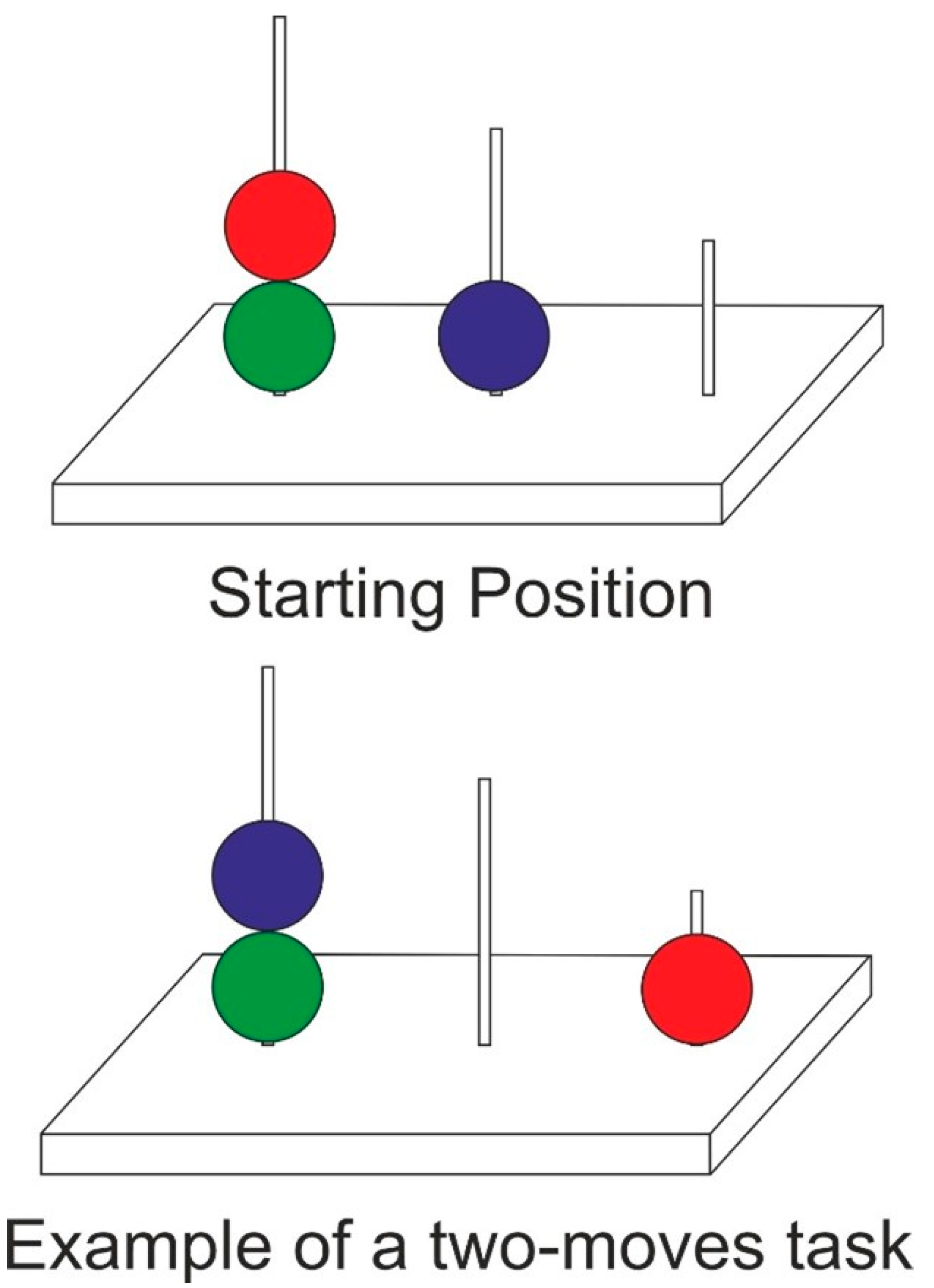
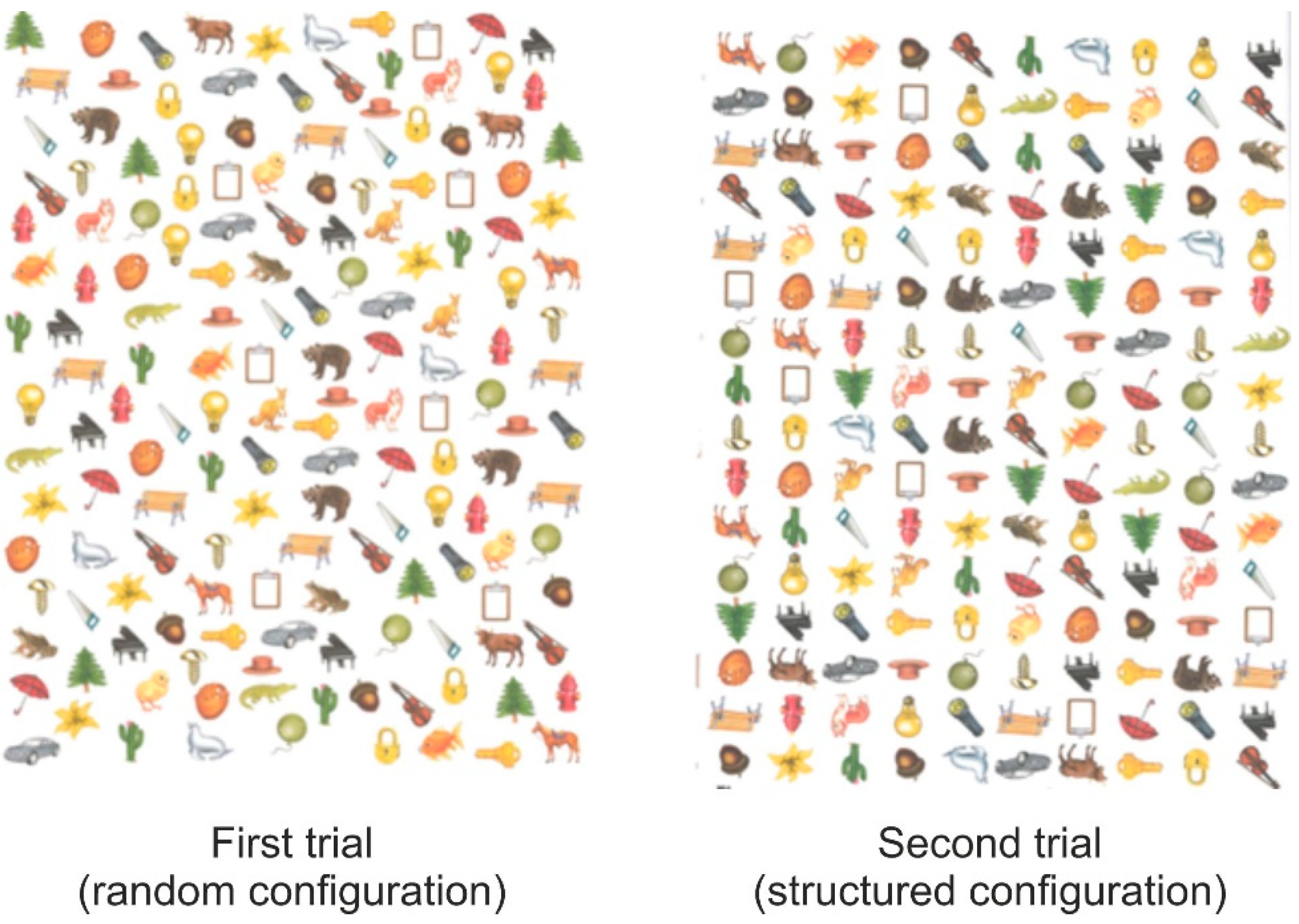
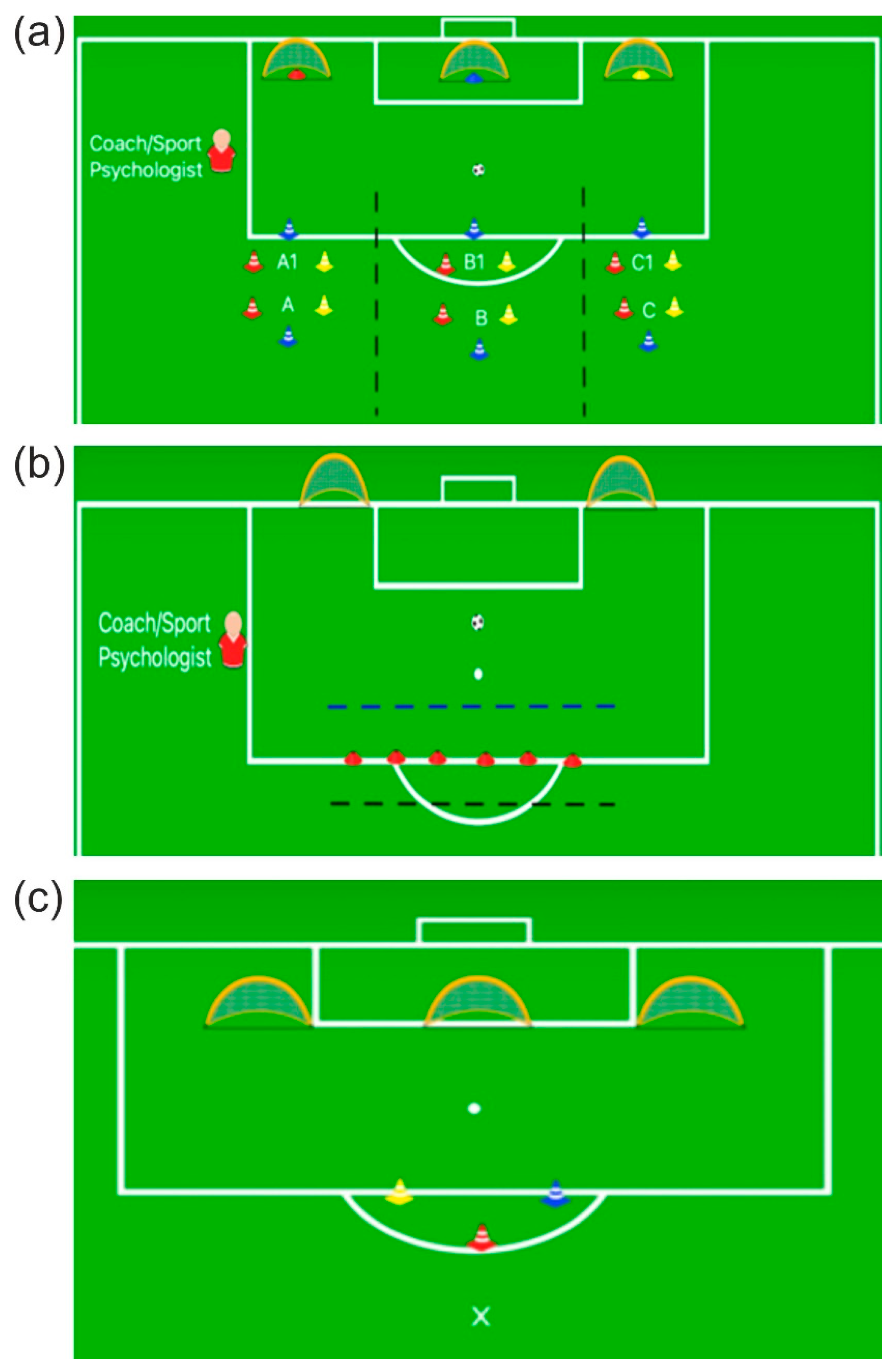
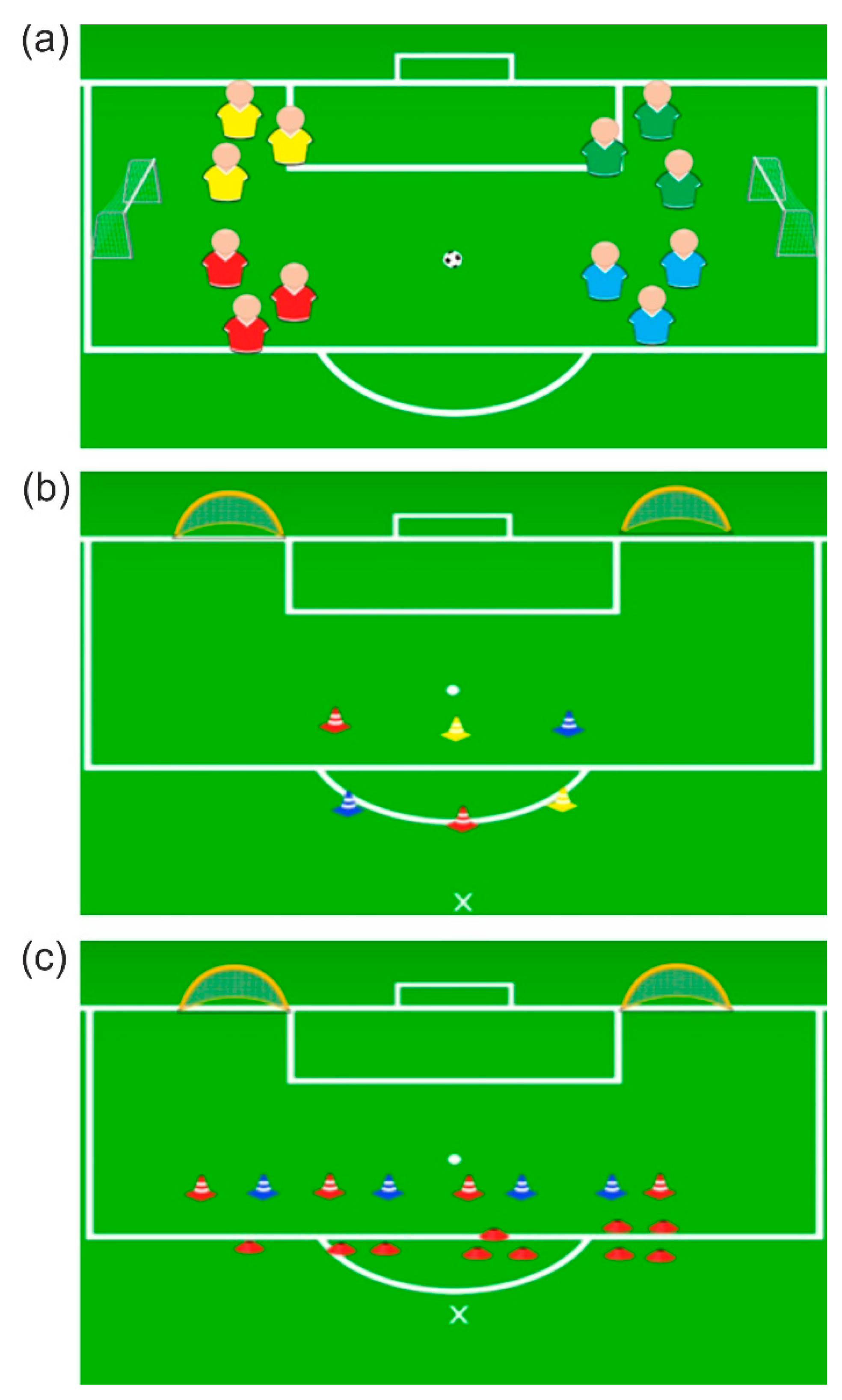

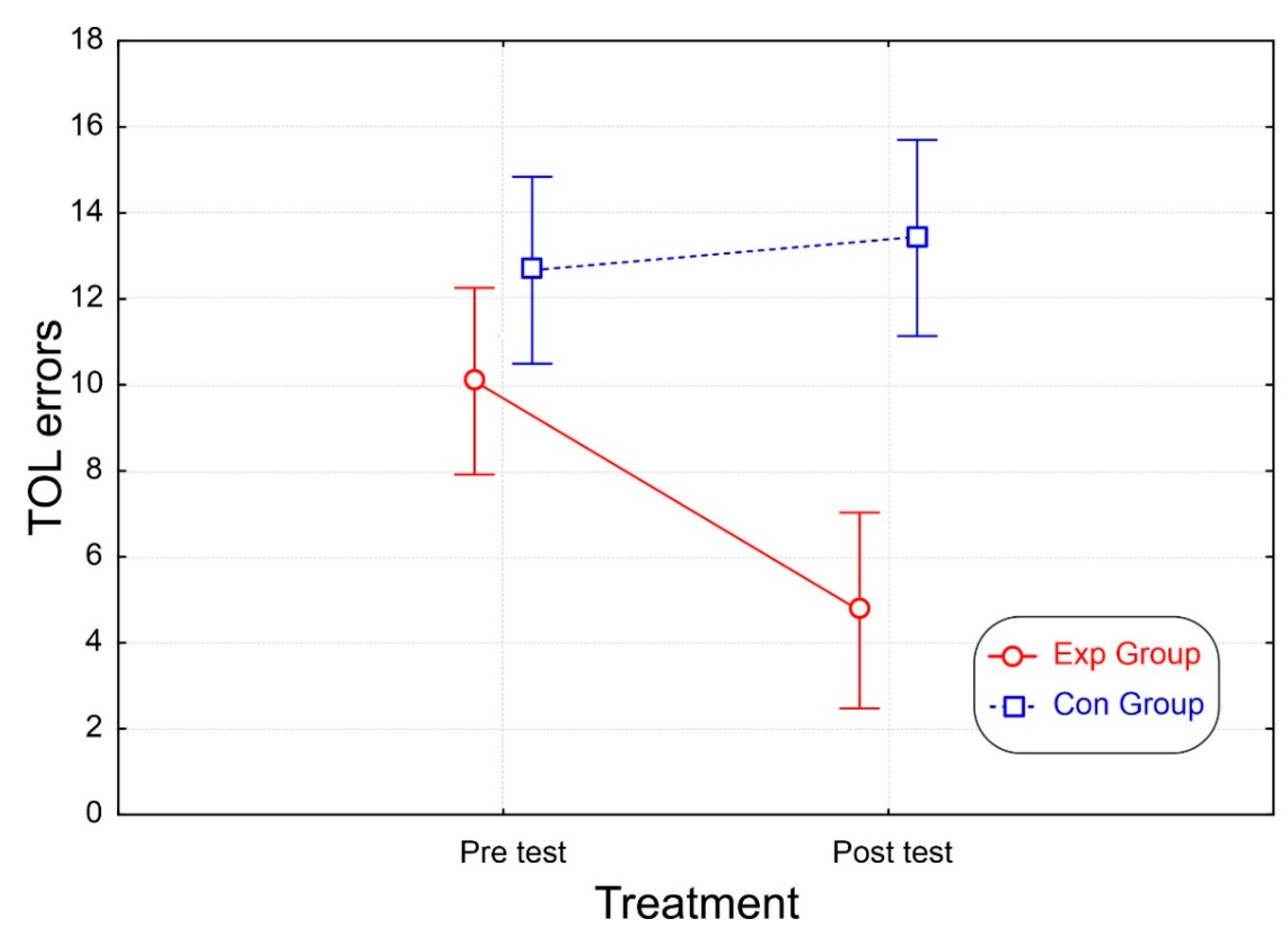
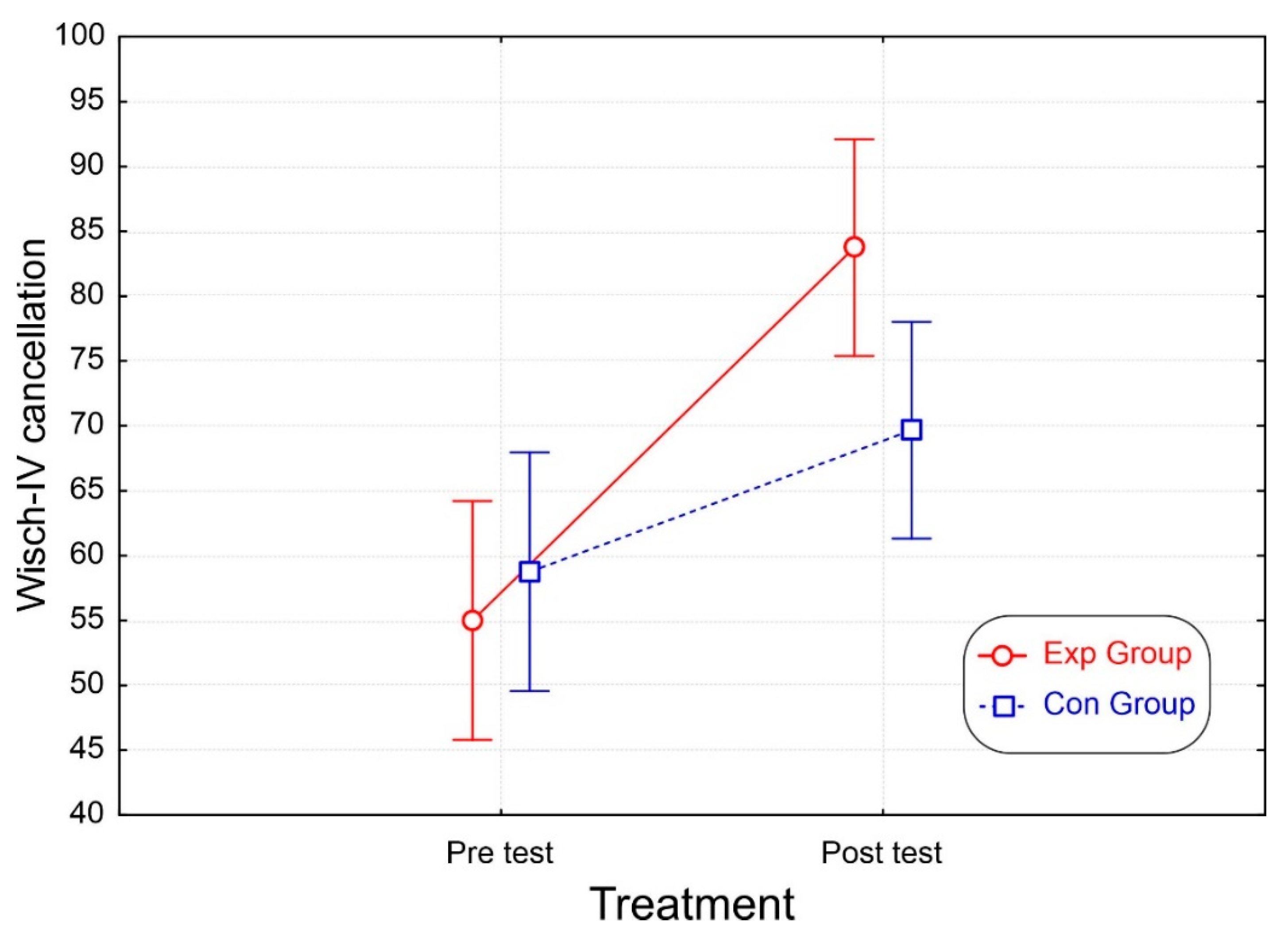
| TOL | DOF | F | p | ηp2 |
|---|---|---|---|---|
| Group | 1, 22 | 13.6 | 0.001 | 0.381 |
| Treatment | 1, 22 | 9.6 | 0.005 | 0.305 |
| Group × Treatment | 1, 22 | 13.4 | 0.001 | 0.379 |
| TOL | DOF | F | p | ηp2 |
|---|---|---|---|---|
| Group | 1, 22 | 18.6 | <0.001 | 0.456 |
| Treatment | 1, 22 | 8.6 | 0.007 | 0.282 |
| Group × Treatment | 1, 22 | 15.2 | <0.001 | 0.409 |
| TOL | DOF | F | p | ηp2 |
|---|---|---|---|---|
| Group | 1, 22 | 1.0 | 0.332 | 0.042 |
| Treatment | 1, 22 | 45.1 | <0.001 | 0.672 |
| Group × Treatment | 1, 22 | 9.1 | 0.006 | 0.293 |
Publisher’s Note: MDPI stays neutral with regard to jurisdictional claims in published maps and institutional affiliations. |
© 2022 by the authors. Licensee MDPI, Basel, Switzerland. This article is an open access article distributed under the terms and conditions of the Creative Commons Attribution (CC BY) license (https://creativecommons.org/licenses/by/4.0/).
Share and Cite
Casella, A.; Ventura, E.; Di Russo, F. The Influence of a Specific Cognitive-Motor Training Protocol on Planning Abilities and Visual Search in Young Soccer Players. Brain Sci. 2022, 12, 1624. https://doi.org/10.3390/brainsci12121624
Casella A, Ventura E, Di Russo F. The Influence of a Specific Cognitive-Motor Training Protocol on Planning Abilities and Visual Search in Young Soccer Players. Brain Sciences. 2022; 12(12):1624. https://doi.org/10.3390/brainsci12121624
Chicago/Turabian StyleCasella, Andrea, Emanuele Ventura, and Francesco Di Russo. 2022. "The Influence of a Specific Cognitive-Motor Training Protocol on Planning Abilities and Visual Search in Young Soccer Players" Brain Sciences 12, no. 12: 1624. https://doi.org/10.3390/brainsci12121624
APA StyleCasella, A., Ventura, E., & Di Russo, F. (2022). The Influence of a Specific Cognitive-Motor Training Protocol on Planning Abilities and Visual Search in Young Soccer Players. Brain Sciences, 12(12), 1624. https://doi.org/10.3390/brainsci12121624






